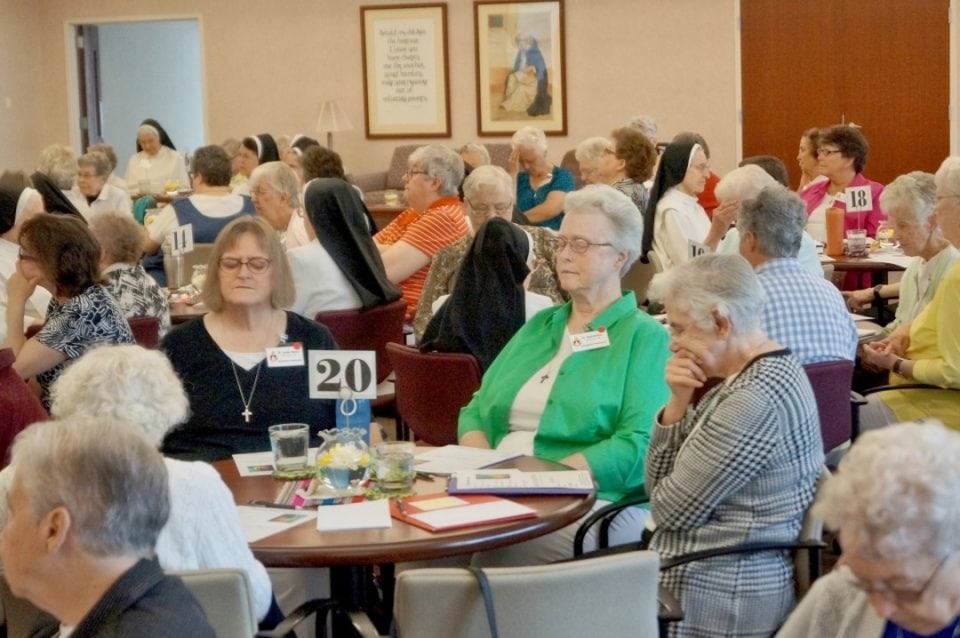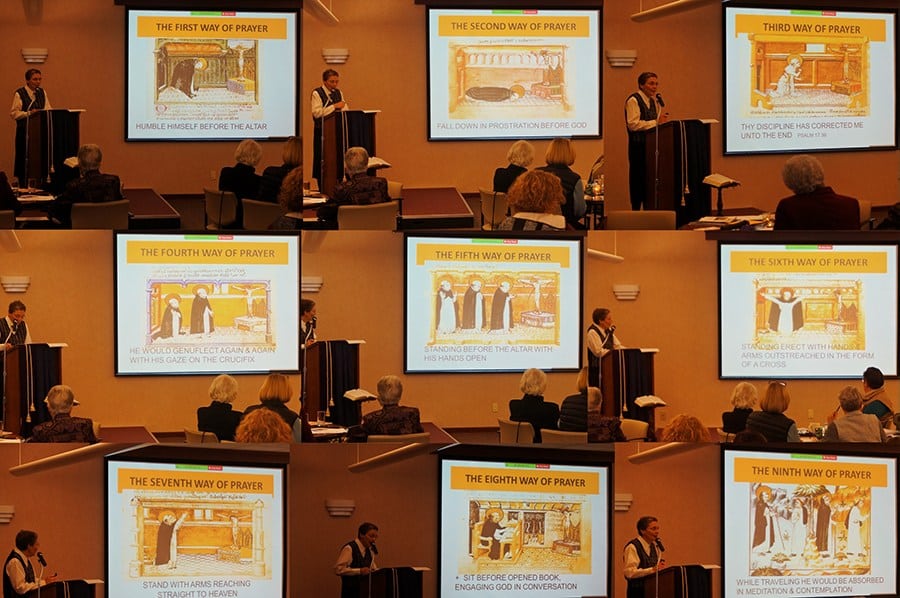
A rich life of prayer is fundamental to Dominican spirituality. Our relationship with God is nourished by daily Eucharist, the prayer of the Church called Liturgy of the Hours, the Rosary, private contemplation, spiritual reading, and intercessory prayer for the needs of the world. Beyond these forms of prayer, which are common to all Catholics, are modes of prayer that may be characteristic of an individual or a specific religious community.
You might hear Dominicans say our characteristic prayer is “whatever works.” There is some truth to that! St. Dominic was quite flexible and practical in his approach to prayer and certainly encouraged his followers to pray in the way they could given the circumstances of their lives. Having said that, there are at least three types of prayer that are common among all Dominicans: praying the Rosary, and praying with scripture, and using our bodies in prayer.
It is the tradition that Mary herself presented Dominic with a Rosary, so that from the earliest days of the Order, the Rosary has been carried or worn by Dominicans and prayed in solitude or in groups.
Books were rare in Dominic’s day, but for many years he carried with him as he traveled the letters of St. Paul and the Gospel of Matthew. Today’s Dominican will be quite familiar with both of these experiences–carrying a Rosary and a Bible or a smaller book that has all of the text of the Catholic liturgy for the month.
Dominic was also known to have prayed quite vigorously with his body, integrating walking, kneeling, bowing, sitting, and other body postures. If you are present in our convents for morning and evening prayer you may see that we still do the same. It’s a healthy practice that keeps you aware of your whole being–body, mind, and spirit, when you pray.
How do you pray? Are any of these foundational prayer types part of your repertoire?
Catholic Mass
Mass is in two parts, Liturgy of the Word–a proclamation and preaching of texts from the Hebrew and Christian Testaments, and Liturgy of the Eucharist, which unites the praying community in the self-sacrifice of Jesus–his passion, death, and resurrection. During Catholic Mass, we experience the divine transformation of the symbols of bread and wine into the Body and Blood of Christ. Through our daily celebration of the Eucharist, we enter into the Paschal Mystery which we are called to preach and to live.
Liturgy of the Hours
Liturgy of the Hours is liturgical prayer offered at fixed times of the day and night. It is also called Daily Office or Morning and Evening Prayer. Elements of liturgical prayer include hymns, psalms, canticles, Scripture readings and intercessory prayer. Morning and Evening Prayer are the bookends to our day, reminding us who we are and whose we are as we pray together for and in the name of the Church.
Want to learn more about the Liturgy of the Hours? Tune in to Episode Four of F.L.O.W.cast Listen, a podcast for the life of the world, to hear our host Jeremiah Washington share with Sister Lori Kirchman what he learned about prayer in the blueberry patch; discuss the church’s ancient prayer and discover ways everyone can integrate Liturgy of the Hours into busy lives.
Contemplation
Our proclamation of the Word demands we make our home in Word of God. We contemplate God’s Word as it is revealed both in Scripture and in our daily lives, and we share with others the fruits of our contemplation. Our experience of Jesus in the People of God prompts us to ponder and meditate upon the mystery we encounter, as well, as we go about our daily lives.
Intercessory Prayer
One fruit of contemplative union with a loving God is compassionate concern for the world, expressed not only in action but also in intercessory prayer, praying for and on behalf of others. We have a very active prayer list. Our sisters pray everyday for the people who come to us with their needs. We are happy to pray for whomever requests our prayer.
Centering Prayer
 In centering prayer, we seek awareness of the presence of God by withdrawing our attention from the ordinary flow of thoughts. Centering prayer cultivates an interior silence which enables us to move into a spiritual realm of intimacy with God.
In centering prayer, we seek awareness of the presence of God by withdrawing our attention from the ordinary flow of thoughts. Centering prayer cultivates an interior silence which enables us to move into a spiritual realm of intimacy with God.
Being attentive to God’s Spirit requires inner quiet. The methodical steps of centering prayer bring our minds to stillness, silence, and concentration. Our goal is to allow God’s presence to become our reality, giving our life meaning, shape, and purpose.
Other Forms of Prayer
Prayer is a means of entering into a conversation with God. We invite you to explore some of these ways to pray, or others that might work for you. If you would like us to pray for you or someone you love, use the Prayer Requests link to contact us. You may also order Prayer Cards created in our community by Sister Maristella Dunlavy, OP, or visit these Daily Prayer Websites.


